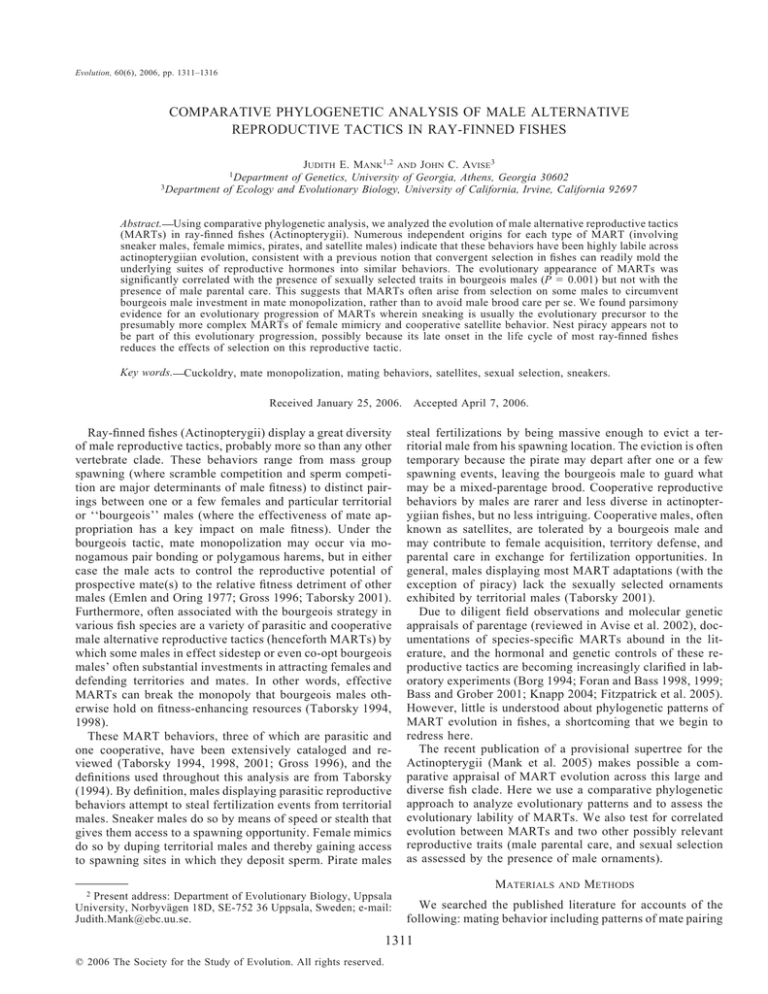
Evolution, 60(6), 2006, pp. 1311–1316
COMPARATIVE PHYLOGENETIC ANALYSIS OF MALE ALTERNATIVE
REPRODUCTIVE TACTICS IN RAY-FINNED FISHES
JUDITH E. MANK1,2 AND JOHN C. AVISE3
of Genetics, University of Georgia, Athens, Georgia 30602
3 Department of Ecology and Evolutionary Biology, University of California, Irvine, California 92697
1 Department
Abstract. Using comparative phylogenetic analysis, we analyzed the evolution of male alternative reproductive tactics
(MARTs) in ray-finned fishes (Actinopterygii). Numerous independent origins for each type of MART (involving
sneaker males, female mimics, pirates, and satellite males) indicate that these behaviors have been highly labile across
actinopterygiian evolution, consistent with a previous notion that convergent selection in fishes can readily mold the
underlying suites of reproductive hormones into similar behaviors. The evolutionary appearance of MARTs was
significantly correlated with the presence of sexually selected traits in bourgeois males (P 5 0.001) but not with the
presence of male parental care. This suggests that MARTs often arise from selection on some males to circumvent
bourgeois male investment in mate monopolization, rather than to avoid male brood care per se. We found parsimony
evidence for an evolutionary progression of MARTs wherein sneaking is usually the evolutionary precursor to the
presumably more complex MARTs of female mimicry and cooperative satellite behavior. Nest piracy appears not to
be part of this evolutionary progression, possibly because its late onset in the life cycle of most ray-finned fishes
reduces the effects of selection on this reproductive tactic.
Key words.
Cuckoldry, mate monopolization, mating behaviors, satellites, sexual selection, sneakers.
Received January 25, 2006.
Ray-finned fishes (Actinopterygii) display a great diversity
of male reproductive tactics, probably more so than any other
vertebrate clade. These behaviors range from mass group
spawning (where scramble competition and sperm competition are major determinants of male fitness) to distinct pairings between one or a few females and particular territorial
or ‘‘bourgeois’’ males (where the effectiveness of mate appropriation has a key impact on male fitness). Under the
bourgeois tactic, mate monopolization may occur via monogamous pair bonding or polygamous harems, but in either
case the male acts to control the reproductive potential of
prospective mate(s) to the relative fitness detriment of other
males (Emlen and Oring 1977; Gross 1996; Taborsky 2001).
Furthermore, often associated with the bourgeois strategy in
various fish species are a variety of parasitic and cooperative
male alternative reproductive tactics (henceforth MARTs) by
which some males in effect sidestep or even co-opt bourgeois
males’ often substantial investments in attracting females and
defending territories and mates. In other words, effective
MARTs can break the monopoly that bourgeois males otherwise hold on fitness-enhancing resources (Taborsky 1994,
1998).
These MART behaviors, three of which are parasitic and
one cooperative, have been extensively cataloged and reviewed (Taborsky 1994, 1998, 2001; Gross 1996), and the
definitions used throughout this analysis are from Taborsky
(1994). By definition, males displaying parasitic reproductive
behaviors attempt to steal fertilization events from territorial
males. Sneaker males do so by means of speed or stealth that
gives them access to a spawning opportunity. Female mimics
do so by duping territorial males and thereby gaining access
to spawning sites in which they deposit sperm. Pirate males
Accepted April 7, 2006.
steal fertilizations by being massive enough to evict a territorial male from his spawning location. The eviction is often
temporary because the pirate may depart after one or a few
spawning events, leaving the bourgeois male to guard what
may be a mixed-parentage brood. Cooperative reproductive
behaviors by males are rarer and less diverse in actinopterygiian fishes, but no less intriguing. Cooperative males, often
known as satellites, are tolerated by a bourgeois male and
may contribute to female acquisition, territory defense, and
parental care in exchange for fertilization opportunities. In
general, males displaying most MART adaptations (with the
exception of piracy) lack the sexually selected ornaments
exhibited by territorial males (Taborsky 2001).
Due to diligent field observations and molecular genetic
appraisals of parentage (reviewed in Avise et al. 2002), documentations of species-specific MARTs abound in the literature, and the hormonal and genetic controls of these reproductive tactics are becoming increasingly clarified in laboratory experiments (Borg 1994; Foran and Bass 1998, 1999;
Bass and Grober 2001; Knapp 2004; Fitzpatrick et al. 2005).
However, little is understood about phylogenetic patterns of
MART evolution in fishes, a shortcoming that we begin to
redress here.
The recent publication of a provisional supertree for the
Actinopterygii (Mank et al. 2005) makes possible a comparative appraisal of MART evolution across this large and
diverse fish clade. Here we use a comparative phylogenetic
approach to analyze evolutionary patterns and to assess the
evolutionary lability of MARTs. We also test for correlated
evolution between MARTs and two other possibly relevant
reproductive traits (male parental care, and sexual selection
as assessed by the presence of male ornaments).
MATERIALS
AND
METHODS
2
Present address: Department of Evolutionary Biology, Uppsala
University, Norbyvägen 18D, SE-752 36 Uppsala, Sweden; e-mail:
Judith.Mank@ebc.uu.se.
We searched the published literature for accounts of the
following: mating behavior including patterns of mate pairing
1311
q 2006 The Society for the Study of Evolution. All rights reserved.
1312
BRIEF COMMUNICATIONS
and MARTs; paternity identification, primarily from genetic
appraisals (Avise et al. 2002), as an indicator of cryptic
MARTs; male ornaments or traits presumably indicative of
sexual selection; and presence and mode of parental care.
MARTs considered here involve sneakers, satellites, female mimics, and pirates (see Introduction). We only included species that have been characterized in the current
literature for mating tactics and behavior. For each characterization from the current literature, we assessed the described MART and assigned the category based on the definitions laid out in Taborsky (1994). Where a species was
documented as exhibiting more than one mating tactic, all
described behaviors were recorded and included in the phylogenetic analysis. Where a family included species that exhibited different tactics, or suites of tactics, each species was
recorded and analyzed in the phylogenetic reconstruction.
More than 150 references, available in the Supplemental Material online only at http://dx.doi.org/10.1554/06-042.1.s1,
comprise this database.
The data on sexually selected traits and male parental investment were originally compiled in Mank et al. (2005) and
can be accessed there. To reduce problems of ascertainment
bias and repeatability, we limited our appraisal of sexually
selected traits to published accounts of male ornaments repeatedly shown to be under sexual selection in various fish
taxa (Mank et al. 2006). These include elongate fins (Harrington 1997; Marcus and McCune 1999; Kuwamura et al.
2000), breeding tubercles (Kortet et al. 2003, 2004), and sexual dichromatism defined as nuptial colors expressed more
noticeably in males than in females (Reimchen 1989; Houde
and Endler 1990; Stott and Poulin 1996; Amundsen and Forgren 2001). We omitted from our database sexually dimorphic traits such as gonopodia and body-size differences that
likely result at least in part from natural selection and are
thus poor proxies for the presence of sexual selection. Finally,
taxa in which males tend embryos or larvae subsequent to
mating were deemed for current purposes to have male parental care, whether or not female parental care was also
involved.
We then mapped this information onto an actinopterygiian
supertree phylogeny constructed (via matrix-representation
with parsimony; Ragan 1992) from 58 previously published
source cladograms which themselves had been based on molecular data or morphological evidence (Mank et al. 2005).
We first estimated numbers of independent origins as well
as transitions among MART character states under maximum
parsimony criteria using MacClade 4 (Maddison and Maddison 2000). We then tested for patterns of correlated evolution between MARTs and other reproductively associated
characters using the maximum likelihood program DISCRETE (Pagel 1994, 1997). Each statistical evaluation of
correlated evolution was conducted using a likelihood ratio
test of the null model of evolution (i.e., with no correlation
between traits) to the alternative correlated model. Each resultant likelihood ratio test has a x2 distribution with four
degrees of freedom (since there are four more parameters in
the null model than in the correlated model; Pagel 1994).
Although DISCRETE can incorporate different branch
lengths (ages of clades) into the analysis, the amalgamated
nature of our supertree (as well as the limited temporal in-
formation in the original source cladograms, due in part to
the limited actinopterygiian fossil record) precluded estimates of absolute divergence times. Thus, we used the standard convention (Mank et al. 2005; Weiblen et al. 2000) of
coding all branch lengths in DISCRETE as equal to one.
RESULTS
We scrutinized published descriptions of mating and reproductive behaviors for 296 species in 86 taxonomic families distributed throughout the Actinopterygii. Figure 1
shows the phylogenetic distribution of MARTs based on this
information, as well as the maximum parsimony reconstructions of ancestral states. For clarity of depiction, all of the
assessed MARTs have been compressed into a single category in Figure 1. However, the parsimony analysis was performed with each MART behavior coded individually. Most
(81%) of the taxonomic families surveyed in this analysis
were monomorphic regarding male mating tactics, with all
species exhibiting identical mating behaviors. Of the 16 families that showed diversity in male mating behavior, the vast
majority of this diversity was comprised of different alternative mating tactics (satellite, sneaker, female mimic, pirate), or suites of tactics in different confamilial species. In
other words, for families with a diversity of tactics, the diversity is due to multiple alternative tactics evolving.
Maximum parsimony reconstruction resulted in several instances of equivocal ancestral states (shown with hatched
shading in Fig. 1), so the numbers provided indicate the range
of evolutionary transitions spanning the minimum and maximum estimate. Our analysis suggests that various MART
behaviors arose independently on at least 26–43 separate occasions during the course of actinopterygiian evolution (Fig.
2A). In 21–27 of these cases, the MART is most-parsimoniously interpreted to have evolved directly from mate monopolization, but the other 5–16 evolutionary origins for
MARTs seem at face value to trace directly to group spawning (Fig. 2A). However, if we assume that distinct pairing
or mate monopolization is normally a direct prerequisite for
MART evolution (see Taborsky 1994, 2001), then these latter
inferred transitions to MARTs might actually have entailed
an intermediate but transient stage of female monopolization
that was not detected in the parsimony analysis.
Inferred transitions from mate monopolization (which we
henceforth assume to be a requisite ancestral state, as described above) to particular types of MARTs are shown in
Figure 2B. According to maximum parsimony reconstruction,
by far the most common evolutionary transition has been to
sneaking (15–20 independent origins). On various occasions,
sneaking was also the inferred transitional state between mate
monopolization and both female mimicry (three to six evolutionary transitions) and cooperative satellite behavior (three
to four evolutionary switches). The parsimony analysis also
suggests that mate monopolization can progress directly to
satellite and female mimic character states without involving
sneaking as an intermediate stage (Fig. 2B). However, it is
also possible that these latter transitions also progressed
through a transitional sneaking state that subsequently was
lost.
Finally, we also tested for correlated evolution between
BRIEF COMMUNICATIONS
1313
FIG. 1. Phylogenetic patterns of male alternative reproductive tactics (MARTs) in ray-finned fishes. Mapped onto the supertree phylogeny
(Mank et al. 2005) are MART observations in extant species and ancestral state reconstructions by maximum parsimony criteria. For
simplicity of presentation, the MART condition displayed here (as solid black branches) is any behavior in an aggregate of sneaking,
piracy, female mimicry, or satellite activity. Also shown are lineages that exhibit either group spawning or some degree of mate
monopolization.
1314
BRIEF COMMUNICATIONS
FIG. 2. Numbers of independent evolutionary transitions (as inferred from maximum parsimony criteria) among reproductive tactics in
ray-finned fishes. Arrow sizes correspond to mean numbers of transitions among states; numbers beside arrows indicate minimum and
maximum estimates. (A) Evolutionary transitions from group spawning to alternative MARTs in ray-finned fishes. The transition from
group spawning directly to MARTs may represent transitions that went through a mate-monopolization intermediate, but were not presently
detected under maximum parsimony (see text). (B) Evolutionary transitions among alternative MART character states, assuming that
mate monopolization is normally the ancestral state. For clarity, only significant transitions (those in which the minimum estimate .0)
are shown.
MARTs and two other reproductive traits. The presence of
male parental care was not statistically associated with
MART evolution (likelihood ratio 5 3.44, ns.), but a
significant evolutionary correlation did prove to exist
between presence of male sexually selected traits and the
evolutionary appearance of MARTs (likelihood ratio 5 8.91,
P 5 0.001).
DISCUSSION
Our comparative phylogenetic analyses indicate that similar MARTs have arisen on numerous separate occasions during the evolution of actinopterygiian fishes. Although our
current tallies of the number of evolutionary transitions will
likely need revision as more published data become available
to further resolve the actinopterygiian supertree, the large
number of changes already inferred between MARTs clearly
paints an overall picture of rapid evolutionary switches
among these alternative reproductive behaviors.
How might these presumably complex behavioral pathways, some of which are genetically embedded and therefore
heritable (Dominey 1980; Ryan and Causey 1989; Zimmerer
and Kallman 1989; Ryan et al. 1992; Heath et al. 2002; Garant
et al. 2003), have arisen so many times over the course of
actinopterygiian evolution? A proximate or mechanistic an-
1315
BRIEF COMMUNICATIONS
swer may lie partly in the hormonal components of reproductive behavior. In a wide variety of fishes, conditional male
reproductive strategies, as well as their associated morphotypes, repeatedly have been shown to be due to differential
expression of the same sets of sex hormones. Endocrine analyses have identified arginine vasotocin (Foran and Bass 1998,
1999; Carneiro et al. 2003), gonadotropin-releasing hormone
(Foran and Bass 1999; Bass and Grober 2001), and 11-ketotestosterone (Brantley et al. 1993; Borg 1994; Ros et al. 2004)
as important hormonal controls affecting MART expression
in species throughout the Actinopterygii.
Increasing evidence from comparative endocrinology also
suggests that the sexual evolutionary plasticity we describe
here may be due to convergent selection on these hormones
(or their receptor proteins) across the clade (Knapp 2004;
Fitzpatrick et al. 2005). Although definitive genetic links
between differential hormonal expression and MARTs are
not yet firmly established, a working hypothesis is that similar
MARTs in different species may share proximate elements
of endocrine expression that ultimately have evolved convergently under selection pressures for or against particular
reproductive tactics, depending upon ecological circumstances (Mank and Avise 2006).
Our phylogenetic analysis, in conjunction with behavioral
reasoning, also suggests that particular evolutionary pathways for MART progression predominate. As summarized
in Figure 2, mate monopolization usually precedes the evolution of sneaking behavior, which in turn may often be a
precursor to female mimicry and cooperative male satellite
tactics. These progressions make sense, as sneaking is often
a conditional strategy based on body size (Gross and Charnov
1980; Mazzoldi and Rasotto 2002; Aubin-Horth and Dodson
2004; Leiser and Itzkowitz 2004) and may require few specialized adaptations. In contrast, female mimicry (which requires that female behaviors and phenotype are decoupled
from gonadal development and gamete production) and male
satellite behavior (which requires the evolution of cooperation between satellites and bourgeois males) are more complex and may therefore be secondary adaptive add-ons. Because sneaking can be a purely body-size-dependent tactic
and thus potentially devoid (at least initially) of a heritable
genetic trigger, it may well precede the evolution of heritable
mechanisms for sneaking, as well as genetic mechanisms for
secondary MARTs involving female mimicry and satellite
behaviors.
Interestingly, our phylogenetic analysis suggests that piracy is not a part of this progression. A combination of factors
may explain this outcome. Piracy is much less common than
sneaking and, being a tactic conditioned primarily on large
body-size, is likely to be exhibited only late in a fish’s life
cycle (most actinopterygiian fish have more or less indeterminate growth in which body size continues to increase with
age). The combination of rarity and late onset may reduce
the effects of selection on this MART, and prevent it from
being readily incorporated into the normal evolutionary pathways of MART progression. However, accounts of piracy are
sparse in the scientific literature, so we cannot refute an alternative possibility that our phylogenetic analysis simply
lacked the power to accurately place this MART in a clear
evolutionary pathway.
Finally, the phylogenetic correlation tests revealed a statistically significant relationship between the presence of sexual selection and the presence of MARTs across evolutionary
lineages. This is hardly unexpected, because the same factors
that foster the evolution of sexually selected traits (namely,
mate monopolization through the differential reproductive
success of bourgeois males; Emlen and Oring 1977) may also
promote the evolution of alternative reproductive tactics by
other males to circumvent such monopolization. It is therefore surprising that we did not also observe a phylogenetic
correlation between MARTs and male parental care. In a
previous analysis of this clade (Mank et al. 2005), we uncovered a significant relationship between male care of offspring and the same sexually selected traits examined here,
initially suggesting to us that sexual selection, MARTs, and
paternal care are all intertwined forces in the evolution of
fish mating systems. Our current analysis may clarify this
relationship by suggesting, more basically, that MARTs are
evolutionary avoidance responses to the costly investments
by bourgeois males in mate monopolization (rather than an
avoidance of male brood care per se). Such costs of mate
monopolization may often include the maintenance of sexually selected traits, defense of territories, and attraction of
females.
ACKNOWLEDGMENTS
This work was supported in part by a National Institutes
of Health training grant to the University of Georgia Department of Genetics (GM07103), and was made possible by
a grant from the American Association of University Women
Educational Foundation (to JEM). We thank two anonymous
reviewers for helpful comments.
LITERATURE CITED
Amundsen, T., and E. Forgren. 2001. Male mate choice selects for
female coloration in a fish. Proc. Natl. Acad. Sci. USA 98:
13155–13160.
Aubin-Horth, N., and J. J. Dodson. 2004. Influence of individual
body size and variable thresholds on the incidence of a sneaker
male reproductive tactic in Atlantic salmon. Evolution 58:
136–144.
Avise, J. C., A. G. Jones, D. Walker, J. A. DeWoody, and others.
2002. Genetic mating systems and reproductive natural histories
of fishes: lessons for ecology and evolution. Annu. Rev. Genet.
36:19–45.
Bass, A. H., and M. S. Grober. 2001. Social and neural modulation
of sexual plasticity in teleost fish. Brain Behav. Evol. 57:
293–300.
Borg, B. 1994. Androgens in teleost fishes. Comp. Biochem. Physiol. 109C:219–245.
Brantley, R. K., J. C. Wingfield, and A. H. Bass. 1993. Sex steroid
levels in Porichthys notatus, a fish with alternative reproductive
tactics, and a review of the hormonal basis for male dimorphisms
among teleost fishes. Hormones Behav. 27:332–347.
Carneiro, L. A., R. F. Oliveira, A. V. M. Canario, and M. S. Grober.
2003. The effect of arginine vasotocin on courtship behaviour
in a blenniid fish with alternative reproductive tactics. Fish Physiol. Biochem. 28:241–243.
Dominey, W. J. 1980. Female mimicry in male bluegill sunfish: a
genetic polymorphism. Nature 284:546–548.
Emlen, S. T., and L. W. Oring. 1977. Ecology, sexual selection,
and evolution of mating systems. Science 197:215–223.
Fitzpatrick, M. J., Y. Ben-Shahar, H. M. Smid, L. E. M. Vet, G.
1316
BRIEF COMMUNICATIONS
E. Robinson, and M. B. Sokolowski. 2005. Candidate genes for
behavioural ecology. Trends Ecol. Evol. 20:96–104.
Foran, C. M., and A. H. Bass. 1998. Preoptic AVT immunoreactive
neurons of a teleost fish with alternative reproductive tactics.
Gen. Comp. Endocrinol. 111:271–282.
———. 1999. Preoptic GnRH and AVT: axes for sexual plasticity
in teleost fish. Gen. Comp. Endocrinol. 116:141–152.
Garant, D., J. J. Dodson, and L. Bernatchez. 2003. Differential
reproductive success and heritability of alternative reproductive
tactics in wild Atlantic salmon (Salmo salar L.). Evolution 57:
1133–1141.
Gross, M. R. 1996. Alternative reproductive strategies and tactics:
diversity within sexes. Trends Ecol. Evol. 11:92–98.
Gross, M. R., and E. L. Charnov. 1980. Alternative male life histories in bluegill sunfish. Proc. Natl. Acad. Sci. USA 77:
6937–6940.
Harrington, M. E. 1997. Behavior patterns and sexual dimorphism
in the spotted dragonet Diplogrammus pauciradiatus (Pisces:
Callionymidae). Bull. Mar. Sci. 60:872–893.
Heath, D. D., L. Rankin, C. A. Bryden, J. W. Heath, and J. M.
Shrimpton. 2002. Heritability and Y-chromosome influence in
the jack male life history of chinook salmon (Oncorhynchus
tshawytscha). Heredity 89:311–317.
Houde, A. E., and J. A. Endler. 1990. Correlated evolution of female
mating preferences and male colour patterns in the guppy Poecilia reticulata. Science 248:1405–1407.
Knapp, R. 2004. Endocrine mediation of vertebrate male alternative
reproductive tactics: the next generation of studies. Integr.
Comp. Biol. 43:658–668.
Kortet, R., J. Taskinen, A. Vainikka, and H. Ylonen. 2003. Breeding
tubercles, papillomatosis, and dominance behavior of male roach
(Rutilus rutilus). Ethology 110:591–601.
Kortet, R., J. Vainikka, M. J. Rantala, I. Jokinen, and J. Taskinen.
2004. Sexual ornamentation, androgens, and papillomatosis in
male roach (Rutilus rutilus). Evol. Ecol. Res. 5:411–419.
Kuwamura, T., K. Karino, and Y. Nakashima. 2000. Male morphological characteristics and mating success in a protogynous
coral reef fish. J. Ethol. 18:17–23.
Leiser, J. K., and M. Itzkowitz. 2004. To defend or not to defend?
Size, residence, and conditional mating in male variegated pupfish, Cyprinodon variegatus. Ethol. Ecol. Evol. 16:299–313.
Maddison, D. R., and W. P. Maddison. 2000. MacClade 4: analysis
of phylogeny and character evolution. Sinauer, Sunderland, MA.
Mank, J. E., and J. C. Avise. 2006. Evolution of reproductive and
genomic diversity in ray-finned fishes: Insights from phylogeny
and comparative analysis. J. Fish Biol. 68:1–27.
Mank, J. E., D. E. L. Promislow, and J. C. Avise. 2005. Phylogenetic
perspectives on the evolution of parental care in fishes. Evolution
59:1570–1578.
Mank, J. E., D. W. Hall, M. Kirkpatrick, and J. C. Avise. 2006.
Sex chromosomes and male ornaments: a comparative evaluation
in ray-finned fish. Proc. R. Soc. Lond. B 273:233–236.
Marcus, J. M., and A. R. McCune. 1999. Ontogeny and phylogeny
in the northern swordtail clade of Xiphophorus. Syst. Biol. 48:
491–522.
Mazzoldi, C., and M. B. Rasotto. 2002. Alternative male mating
tactics in Gobius niger. J. Fish Biol. 61:157–172.
Pagel, M. 1994. Detecting correlated evolution on phylogenies, a
general method for the comparative analysis of discrete characters. Proc. R. Soc. Lond. B 255:37–45.
———. 1997. Inferring evolutionary process from phylogenies.
Zool. Scr. 26:331–348.
Ragan, M. A. 1992. Phylogenetic inference based on matrix representation of trees. Mol. Phylogenet. Evol. 1:53–58.
Reimchen, T. E. 1989. Loss of nuptial color in threespine sticklebacks (Gasterosteus aculeatus). Evolution 43:450–460.
Ros, A. F. H., R. Bruintjes, R. S. Santos, A. V. M. Canario, and
R. F. Oliveira. 2004. The role of androgens in the trade-off
between territorial and parental behavior in the Azorean rockpool blenny, Parablennius parvicornis. Hormones Behav. 46:
491–497.
Ryan, M. J., and B. A. Causey. 1989. ‘‘Alternative’’ mating behavior in the swordtails Xiphophorus migrensis and Xiphophorus
pygmaeus (Pisces: Poeciliidae). Behav. Ecol. Sociobiol. 24:
341–348.
Ryan, M. J., C. M. Pease, and M. R. Morris. 1992. A genetic polymorphism in the swordtail Xiphophorus nigrensis: testing the
prediction of equal fitnesses. Am. Nat. 139:21–31.
Stott, M. K., and R. Poulin. 1996. Parasites and parental care in
male upland bullies (Eleotridae). J. Fish Biol. 48:283–291.
Taborsky, M. 1994. Sneakers, satellites, and helpers: parasitic and
cooperative behavior in fish reproduction. Adv. Study Behav.
23:1–100.
———. 1998. Sperm competition in fish: ‘‘bourgeois’’ males and
parasitic spawning. Trends Ecol. Evol. 13:222–227.
———. 2001. The evolution of bourgeois, parasitic, and cooperative reproductive behaviors in fishes. J. Hered. 92:100–110.
Weiblen, G. D., R. K. Oyama, and M. J. Donoghue. 2000. Phylogenetic analysis of dioecy in monocotyledons. Am. Nat. 155:
46–58.
Zimmerer, E. J., and K. D. Kallman. 1989. Genetic basis for alternative reproductive tactics in the pygmy swordtail, Xiphophorus nigrensis. Evolution 43:1298–1307.
Corresponding Editor: E. Brainerd







